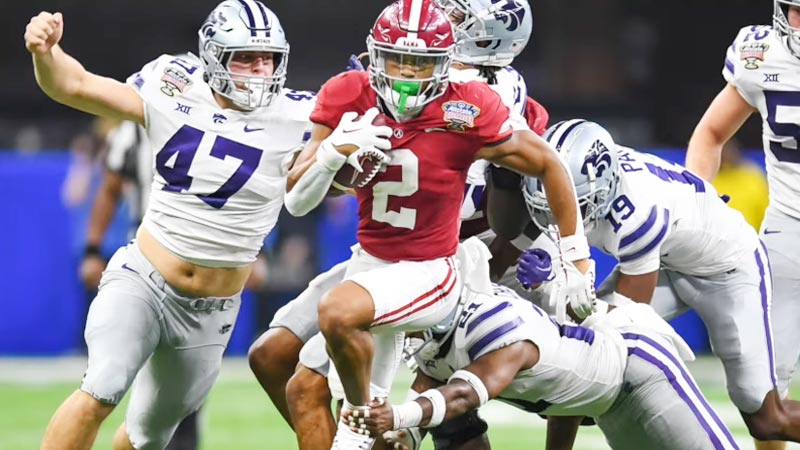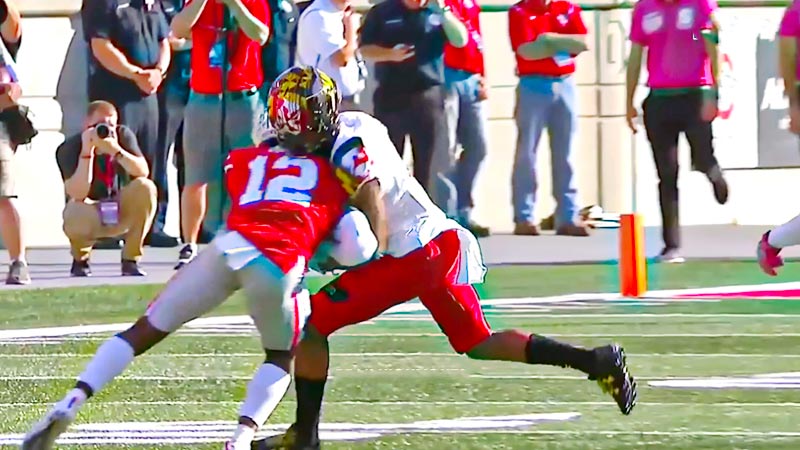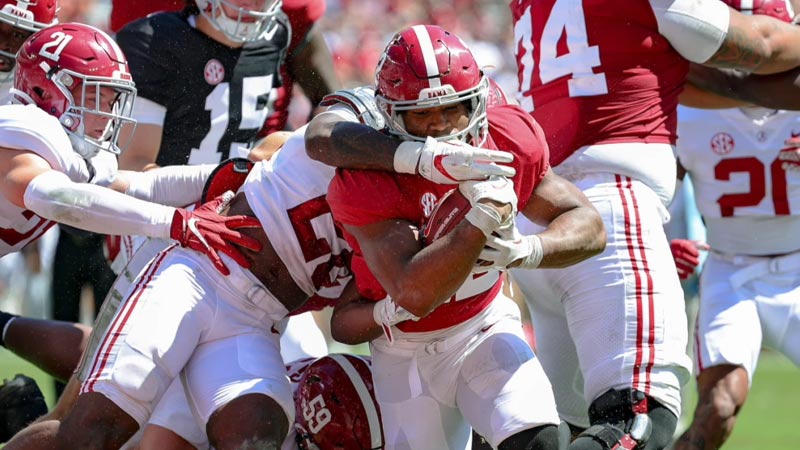In the dynamic realm of American football, the role of strong safety is as crucial as it is demanding. A strong safety is a defensive player who plays a pivotal role in both pass coverage and runs defense, bridging the gap between the linebackers and cornerbacks.
This multifaceted position requires a unique blend of speed, strength, and strategic acumen. As the last line of defense against long passes and a formidable force against running plays, strong safeties are key players in modern defensive schemes.
This article delves into the intricacies of the football’s strong safety position, shedding light on its responsibilities, attributes, and impact on the game.
What Is Football Strong Safety?
A football strong safety is a defensive player positioned in the secondary, primarily in American football. This player plays close to the line of scrimmage and is responsible for stopping the run, covering tight ends, and providing support against short passes.
Strong safeties are known for their physicality, tackling ability, and versatility. They must read plays quickly to react to both run-and-pass situations.
Their role requires a mix of strength, agility, and coverage skills. In certain defensive schemes, strong safeties might also blitz the quarterback.
Their contributions are pivotal in providing overall defensive stability, making impactful tackles, and disrupting opposing offenses.
Role of the Players in the Strong Safety
In a football defense, strong safety plays a crucial role as part of the secondary. Their responsibilities include:
Run Support
Strong safeties are often positioned closer to the line of scrimmage to help defend against running plays. They must quickly diagnose the play and fill gaps to make tackles and limit gains by opposing running backs.
Coverage
Strong safeties are also responsible for covering tight ends, slot receivers, and sometimes even running backs in pass coverage. They need to have good coverage skills, anticipation, and the ability to disrupt passing routes.
Tackling
Strong safeties are known for their tackling ability. They must be reliable tacklers to bring down ball carriers effectively, both in run defense and after short passes.
Blitzing
Depending on the defensive scheme, strong safeties might be called upon to blitz the quarterback. Their ability to time their blitzes, create pressure, and disrupt the opposing quarterback is important for defensive success.
Read and React
Strong safeties must quickly read the quarterback’s intentions and the offensive formation to make split-second decisions on whether to defend against the run or the pass.
Communication
Strong safeties often serve as communication hubs in the secondary, relaying information and adjustments to their fellow defensive backs based on the offense’s formation and pre-snap movements.
Versatility
Modern strong safeties are expected to be versatile players who can excel in both physical run defense and coverage situations. They need to be agile enough to cover receivers while still being able to deliver impactful hits.
Strong safety is a dynamic player who must excel in various aspects of the game, contributing to the defense’s ability to stop both the run and the pass effectively.
Defense Back in the Strong Safety

A defensive back, specifically in the role of a strong safety, is a versatile player who plays a critical role in the defensive secondary of a football team. Here’s an overview of their responsibilities:
Run Support
Strong safety is a key player in stopping the run game. They’re positioned closer to the line of scrimmage, often in the box, to provide immediate support against running plays. They read the offensive formation and react quickly to fill gaps and make tackles.
Pass Coverage
Strong safeties need to cover a range of offensive players, including tight ends, slot receivers, and sometimes even running backs coming out of the backfield. They must use their coverage skills to prevent passes from being completed and disrupt the timing of routes.
Zone and Man Coverage
Depending on the defensive scheme, strong safeties might be assigned to cover a specific area of the field (zone coverage) or match up directly against an assigned receiver (man coverage). They must excel in both techniques to provide effective coverage options.
Tackling
A strong tackling ability is a hallmark of a successful strong safety. They often face powerful ball carriers and must bring them down reliably, both in open-field situations and near the line of scrimmage.
Blitzing
In certain defensive schemes, strong safeties are tasked with blitzing the quarterback to apply pressure and disrupt passing plays. Their timing and ability to penetrate the offensive line are crucial in this role.
Reading the Play
Strong safeties need to quickly read the quarterback’s intentions, recognize offensive patterns, and react accordingly. This skill helps them anticipate passes, make interceptions, and break up plays.
Communication
Strong safeties often communicate defensive adjustments and coverage assignments to the rest of the secondary. They help ensure that the defensive unit is aligned properly to counter the offense’s strategies.
Ball Skills
A strong safety’s ability to track the ball, make interceptions, and force fumbles contributes to creating turnovers and shifting momentum in favor of their team.
Versatility
In today’s game, strong safeties are expected to have a balanced skill set, excelling in both physical run defense and coverage situations. They need to be agile and fast enough to cover receivers while being physically imposing enough to tackle effectively.
In essence, a strong safety is a multifaceted defensive back who can impact various aspects of the game, from stopping the run to disrupting passing plays and providing leadership in the secondary.
Strategies of the Players in Strong Safety

Players in the strong safety position employ a range of strategic approaches to excel in their role on the football field. Here are some key strategies they utilize:
Reading the Offense
Strong safeties study the opposing offense’s tendencies, formations, and pre-snap movements to anticipate plays. This allows them to react quickly and be in optimal positions to defend against both the run and the pass.
Gap Discipline
Against the run, strong safeties must maintain proper gap discipline. They read the offensive line and ball carrier’s movements to fill gaps effectively and prevent running backs from gaining yards.
Coverage Techniques
Depending on the defensive play call, strong safeties use various coverage techniques, such as playing in zone coverage to cover specific areas of the field or using man-to-man coverage to shadow receivers.
Route Recognition
Strong safeties analyze receivers’ routes to predict where the ball might be thrown. This helps them position themselves to break up passes or make interceptions.
Tackling Fundamentals
A solid tackling technique is essential for strong safeties. They aim to wrap up ball carriers, drive through their legs, and bring them down securely to prevent extra yardage.
Physicality and Intimidation
Strong safeties often use their physical presence to intimidate receivers and disrupt their routes. This psychological aspect of the game can affect an opponent’s performance.
Blitz Timing
When called upon to blitz, strong safeties must time their rushes well to catch the offense off guard. This involves reading the snap count and finding the right moment to attack the quarterback.
Recognition of Play-Action
Strong safeties need to differentiate between run and play-action plays quickly. They must recognize if the quarterback is handing off the ball or dropping back to pass, adjusting their positioning accordingly.
Communication
Strong safeties communicate with other members of the defense to convey adjustments, coverage assignments, and potential threats. Clear communication helps the entire unit function cohesively.
Ball Awareness
Strong safeties focus on tracking the ball during passing plays, anticipating its trajectory, and timing their attempts to intercept it or deflect it away from receivers.
Film Study
In preparation for games, strong safeties watch game footage to analyze the tendencies and preferences of opposing offenses and quarterbacks. This helps them make informed decisions during the game.
Adaptation
Strong safeties must adapt to changing game situations, offensive formations, and play-calling. They adjust their positioning and approach based on the flow of the game.
Incorporating these strategies allows strong safeties to contribute effectively to their team’s defense, influencing both run defense and pass coverage while creating opportunities for turnovers and game-changing plays.
Difference Between a Free Safety And a Strong Safety in Football
In American football, the roles of free safety and strong safety are distinct positions within the defensive secondary. While both positions are part of the safety position group, they have different responsibilities and skill sets.
Here are the key differences between free safety and strong safety:
Free Safety
- Coverage Emphasis: Free safeties are often positioned deeper in the secondary and are primarily responsible for providing coverage against deep passes. They play the “centerfield” role, helping prevent long passes from being completed.
- Ballhawk Skills: Free safeties are known for their ability to read the quarterback’s intentions, track the ball in the air, and make interceptions. They have excellent ball skills and play a critical role in creating turnovers.
- Range and Speed: Free safeties typically have great speed and range, allowing them to cover a large area of the field and provide support to cornerbacks on deep routes.
- Zone Coverage: They excel in zone coverage schemes, where they cover specific areas of the field and help defend against passes that go beyond the intermediate range.
- Communication: Free safeties often communicate coverage adjustments and inform their teammates about potential threats they observe from their deep position.
- Less Focus on Run Support: While free safeties are not completely exempt from defending against the run, their primary role is in pass coverage, and they are less involved in stopping running plays at the line of scrimmage.
Strong Safety
- Run Support: Strong safeties are positioned closer to the line of scrimmage and have a more significant role in run support. They are responsible for stopping running plays, filling gaps, and making tackles near the line of scrimmage.
- Physicality: Strong safeties are generally more physically imposing and emphasize tackling ability. They need to take on blockers, shed blocks, and bring down ball carriers effectively.
- Tight End and Slot Receiver Coverage: Strong safeties often cover tight ends, slot receivers, and sometimes even running backs in coverage. They need to be able to defend against shorter passes and be physically competitive against larger offensive players.
- Blitzing: Strong safeties are more frequently used as blitzes to pressure the quarterback. They contribute to pass rush schemes and disrupt the opposing team’s passing game.
- Hybrid Role: Modern strong safeties are expected to have a balance of coverage skills and run-stopping ability, allowing them to excel in various defensive situations.
- Versatility: They must be versatile players who can switch between defending against the run, covering receivers, and even rushing the passer.
While both free safeties and strong safeties are essential components of a football defense, they have distinct roles based on their positioning, responsibilities, and skill sets. Free safeties focus on deep pass coverage and interceptions, while strong safeties emphasize run support, physicality, and versatility.
FAQs
What are the primary responsibilities of strong safety?
A strong safety is responsible for covering tight ends and receivers, providing run support, and occasionally blitzing the quarterback.
What skills are essential for a successful strong safety?
A successful strong safety needs excellent tackling, coverage, and ball-tracking skills, along with the ability to read offensive plays quickly.
How does strong safety differ from free safety?
While both safeties share coverage duties, strong safeties are generally more physical, focusing on short-to-intermediate passes and run defense.
What impact does strong safety have on the team’s defense?
A skilled strong safety can disrupt passing lanes, force turnovers, and stifle opposing running games, providing a versatile defensive presence.
Who are some legendary strong safeties in football history?
Notable strong safeties include Ronnie Lott, Troy Polamalu, and Kam Chancellor, who set standards for excellence in the position.
Wrapping Up
In the intricate tapestry of American football, the strong safety stands as a linchpin of defensive strategies. Their ability to seamlessly transition from coverage to run support, their knack for creating turnovers, and their physical presence make them indispensable assets on the field.
From guarding against deep passes to shutting down running plays, the football’s strong safety personifies adaptability and versatility.
Understanding their role enhances the appreciation of defensive intricacies in a sport celebrated for its blend of strategy and physicality.
Have a nice day.







